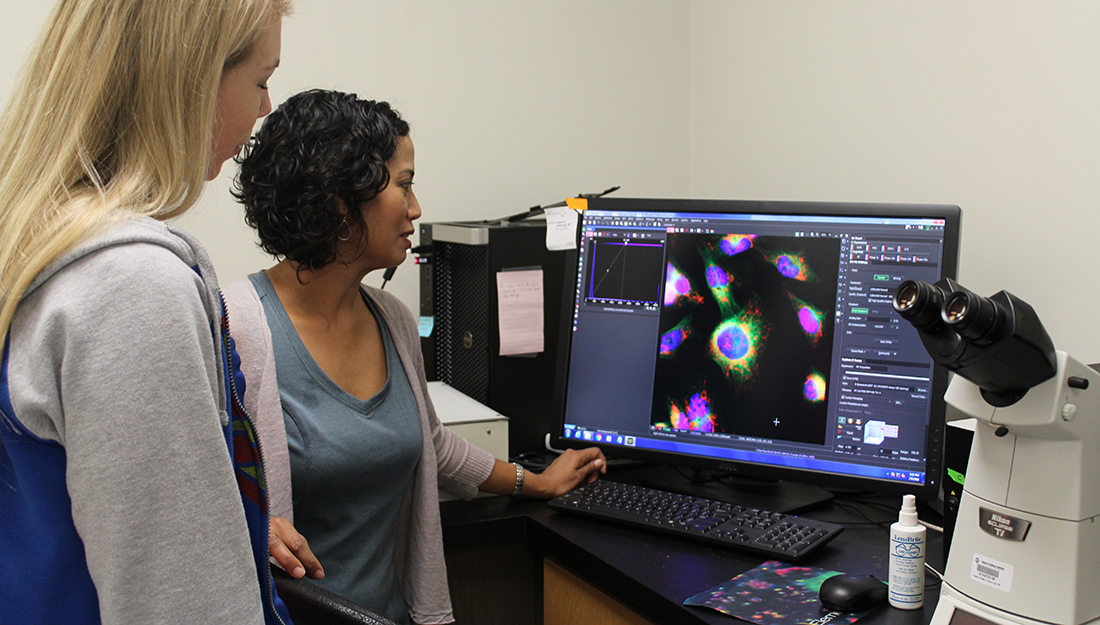- Christina Sumners
- Medicine, Research, Show on VR homepage
Battle Against Brain Cancer
Texas A&M researcher conquers new territory

Basic science researchers are interested in understanding how cells receive signals and how they function and behave. They differ from translational researchers, who strive to transition their findings from bench to bedside by creating new therapies for diseases. Raquel Sitcheran, PhD, a basic science researcher at Texas A&M College of Medicine, has recently adopted more translational approaches in her research on cancer pathways following the tragic death of her daughter from a brainstem glioma.
Sitcheran’s research seeks to understand the biology of high-grade gliomas, a highly aggressive and lethal form of brain cancer, and improve gliomas identification and treatment. Sitcheran turned the most traumatic experience of her life into a source of motivation, embodying the resilience of the human spirit as she works to save others from the heartbreaking loss of a family member to brain cancer.
People outside the world of medical research view cancer as a single entity. Cancer actually behaves more like a team. Whether on the field or court, athletes deliberately create different points of attack and defense to adapt to the conditions of each individual game. Cancer cells behave in much the same way and are willing to go to any lengths necessary to overcome their opponents.
By changing the expression of certain genes and the regulation of metabolism, cancer is exceptionally good at adapting to its host. While sports teams may get trophies or money from a win, cancer’s ultimate goal is more lethal. Certain malignant cancers, like gliomas in the brain, only have one task—to proliferate and invade, eventually overwhelming their host and causing death. However, recent breakthroughs by Sitcheran may change this.
Sitcheran’s lab identified a protein that may potentially be used as a therapeutic target for cancer cells. This protein, NF-kappa-B-inducing kinase, more commonly referred to as NIK, is a key player in gliomas that regulates this cancer’s ability to use energy and to adapt to its environment. In her experiments, NIK was knocked out, preventing glioma cells from growing and adapting to their environment. Essentially, this stopped the progression of brain cancer. Sitcheran’s discovery has identified an important control center that may be used to disassemble brain cancer’s cohesive team.
Sitcheran’s life story played a major role in her work as a tenured associate professor in the Department of Cellular and Molecular Medicine. After joining the college of medicine in 2009, she decided to continue researching the NF-kappa-B-pathway that she had previously studied during her post-doctoral research. However, she wanted to examine a different branch of the pathway that previously had not been widely studied. “This NF-kappa-B pathway is an evolutionarily conserved pathway, meaning that it has been around for many generations,” Sitcheran says. “We know that it is really involved in controlling many aspects of cancer cell growth and development, and I started studying a branch of this pathway that was less studied in cancer. I found that the branch of the pathway with the NIK protein was important in brain tumors.”
Sitcheran was interested in learning the role of the NIK protein and its mechanism of action in the pathway, but did not have plans to translate her research into cancer treatment options. However, her research and life priorities changed when her daughter was diagnosed a year after she started her research position at the Health Science Center.
A Parent’s Worst Nightmare
The words diffuse intrinsic pontine glioma, or DIPG, may not mean much to the average person. For those in the field of neuroscience, those four words are understood to be a death sentence. DIPG is a highly aggressive and deadly type of brain tumor that is located in the brain stem and is incredibly resistant to chemotherapy and other treatments. DIPG is the most common brainstem tumor in children and has a median overall survival rate of less than one year. In 2010, Sitcheran’s daughter, Isabel, was diagnosed with DIPG. In May of 2011, Isabel died at the age of 8. “It was the hardest thing that we have gone through, watching that tumor literally paralyze her until she died,” Sitcheran says. “After she died, I almost quit research altogether.”
Even with her daughter’s illness and eventual death weighing on her, Sitcheran managed to keep her lab running, but it significantly impacted the pace of her research. “After my daughter passed away, I started to question studying those basic mechanisms,” she says. “I thought ‘This is just pointless. I should just be screening drug after drug to find a new therapy.’”
As she worked through the grieving process, Sitcheran gradually changed her mindset about her tragedy to serve as a source of motivation to research. “Even when I wanted to quit, I thought, ‘What am I going to do?’” she recalls. “I am probably doing the best to keep doing what I’m doing.’”
She thought about how she could use the information she discovered about the protein NIK to eventually develop a therapy that would slow the progression of aggressive brain tumors. “It took me a while to rediscover the joy of that basic science,” Sitcheran says. “You have to know what it is that you are trying to target. You can’t just screen through drugs. We do need to better understand all the molecular underpinnings and pathways that are regulators of cancer. Basic science is fundamental, even if it is not immediate.”
Sitcheran does not study DIPG, but she thinks there should be more effort to increase funding for pediatric brain cancer. “They are considered ‘rare’ tumors because population-wise, there aren’t that many people that get them,” Sitcheran explains. “They are so underfunded compared to prostate and breast cancer. When you think about the loss of life compared to funding, there is a big disparity there.”
After being awarded tenure in 2017, Sitcheran decided to use her personal experience with pediatric brain cancer to broaden her field of study. “We are starting to study pediatric cancers,” she says. “Most of everything that we have done so far has been in adult brain tumors. One of the reasons that we are starting to move into the pediatric realm is because of my own personal connection to pediatric cancer.”
Sitcheran’s tragedy gave her a new appreciation of how challenging pediatric cancer is to treat. “They are not mini versions of adult tumors,” she says. “They have different molecular drivers and they are different entities. For treating pediatric cancer, all the drugs have to be approved through adult trials first. However, those drugs and pathways being studied in adults might not be the most relevant for pediatric cancer.
The Path to Success
Born and raised in Jamaica, Sitcheran came to America when her family moved to Queens, New York, when she was 7. Growing up, Sitcheran was fascinated with science. She attended the Bronx High School of Science, a very selective public high school in New York City. Upon graduation, Sitcheran pursued her dream of becoming a scientist and was admitted to Columbia University, becoming the first in her family to attend college.
For the majority of her undergraduate career, she was on the pre-med track with the notion that medical school was the only professional career for full-time scientists. Sitcheran never knew she could join a research lab or pursue a Ph.D. in the sciences. When she learned her friends were getting research positions, she secured an undergraduate research position at Columbia with Richard Axel, a prominent neuroscientist who later received the Nobel Prize in 2004. In the Axel lab, Sitcheran explored the world of research science and eventually decided to obtain a doctorate instead of going to medical school.
Upon graduation, Sitcheran was accepted to a graduate program at the University of California, San Francisco, in Keith Yamamoto’s lab. “I loved Columbia and New York, but I felt like if I didn’t leave, then I was never going to leave, or that it was going to be more traumatic for me to leave later,” Sitcheran shares. “So, I did the extreme and went to the other coast.”
After obtaining her Ph.D. in physiology and genetics, she began a post-doctoral position at the University of North Carolina, Chapel Hill, in Albert Baldwin’s lab, where she studied the NF-kappa-B-pathway that controls immunity and inflammation. After completing her post-doctoral work, she arrived in College Station in 2009 and joined the College of Medicine as an assistant professor.
Hopes for the Future
Though cancer research has come a long way over the years, Sitcheran doesn’t think medical scientists will cure cancer in the near future. “It’s not that we haven’t learned a ton,” she says. “It’s just that there is so much more to learn. I know there’s a lot of talk about the fact that, ‘There has been so much money invested in cancer research, so why isn’t it cured yet?’ It’s because it’s not easy. There are so many things that are unknown. There are still so many questions that we have to answer.”
In her own research, Sitcheran says she hopes to eventually enter the clinical trial phase to develop a NIK inhibitor specifically targeted to brain tumor cells. Her two main concerns for the development of this treatment are figuring out how to get the treatment to glioma cells and how to specifically direct a drug to those cells.
“If you administer a treatment systemically, you may be hitting things in the body that you don’t want to hit,” Sitcheran explains. Though her research has contributed greatly to the fight against gliomas, brain cancer’s exceptional ability to function as a multifaceted team stands in the way of a cure.
As she works toward learning more about NIK and its role in glioma growth and proliferation, Sitcheran continually demonstrates her incredible resilience through her efforts to find a cure for cancer. “My experience with [Isabel] underlies everything,” she says. “Regardless of her being my child, it is that experience with cancer that I had always studied in the abstract. When I really went through that, I think it really gave me a deeper motivation to do what I do. I am still the same scientist, but now I have a different level of motivation.”
This article, written by Sarah Elmer, originally appeared in Insite Magazine. Photo credit: Sarah Elmer
Media contact: media@tamu.edu


